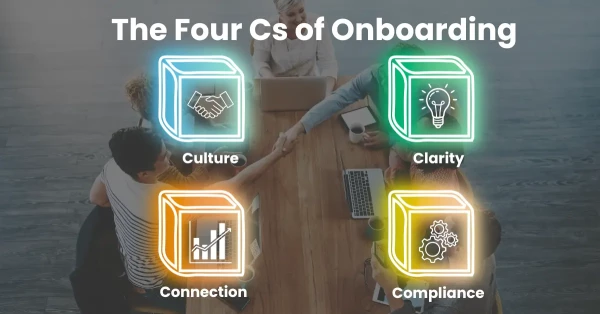The initial period of employment—the onboarding phase—is arguably the most critical juncture in the entire employee lifecycle. Our expertise in HR, employee relations, and psychology confirms that it is a period of intense psychological vulnerability for the new hire, a make-or-break experience that dictates long-term employee retention and employee engagement. Organizations with a strong, structured onboarding process can dramatically improve new hire retention and productivity.
The central question facing modern organizations is: How can we transform the administrative checklist of onboarding into a deeply engaging, effective, and psychologically safe process that drives sustained commitment? The answer lies in shifting the focus from mere compliance to the holistic integration of the new hire, utilizing continuous feedback mechanisms—specifically, strategic employee surveys—as the primary tool for measuring and optimizing this delicate transition.
The Four Cs of Onboarding: A Psychological Framework
An effective onboarding strategy must go beyond paperwork. Based on established organizational psychology principles, successful integration is built on the "Four Cs" framework, each addressing a core psychological need of the new employee:
|
Core Psychological Need |
The "C" of Onboarding |
HR Focus/Definition |
|
Certainty & Structure |
Compliance |
Legal/policy paperwork; facility and tool access; system logins. |
|
Competence & Control |
Clarification |
Role expectations; 30-60-90 day goals; performance metrics; organizational chart. |
|
Meaning & Value |
Culture |
Mission, vision, and values; unwritten rules; social norms; company history. |
|
Belonging & Safety |
Connection |
Peer-to-peer relationships; manager relationship; assignment of a buddy/mentor. |
An organizational failure in any of these areas creates "job shock," leading to early disengagement and high employee turnover risk in the first 90 days. For instance, a failure in clarification leads to role ambiguity, one of the top predictors of early resignation. A failure in connection leads to isolation, directly undermining psychological safety—the ability to ask questions, admit mistakes, and voice concerns without fear of penalty.
The Onboarding Design Challenge: Navigating the Trade-Offs
The design of a successful program requires navigating complex trade-offs that challenge HR and leadership. Our experience in this field shows these decisions are rarely simple:
1. Trade-Off: Efficiency (Compliance) vs. Personalization (Connection)
-
The Challenge: Digital HR technology excels at efficiency, automating compliance tasks and pre-boarding paperwork (e.g., offer letters, forms). This is crucial for saving HR time and ensuring legal adherence. However, an overly automated, impersonal process can signal that the employee is just a number.
-
The Psychological Impact: New hires are looking for a reciprocal relationship. A personal welcome video from the manager or CEO (addressing the psychological principles of authority and liking) before Day One provides that human touch, ensuring the employee feels valued and special, reducing the risk of "ghosting" before the start date.
-
The Solution: Use HR Technology to manage the transactional work (paperwork, system access) via a seamless pre-boarding process, freeing up managers and peers to focus on the relational work (lunches, introductions, mentorship).
2. Trade-Off: Standardization vs. Cultural Sensitivity
-
The Challenge: Standardized onboarding ensures consistency across the organization, which is often easier to manage and measure. However, a one-size-fits-all approach often fails to account for diverse work styles, cultural backgrounds, and the specific needs of different departments (e.g., engineering vs. sales).
-
The Psychological Impact: New hires from diverse backgrounds may struggle with unstated cultural conventions. They need clear guidance on hierarchy, communication styles, and work-life expectations. A lack of cultural sensitivity fosters a sense of exclusion rather than belonging.
-
The Solution: While the core compliance and clarification stages remain standard, the culture and connection stages must be localized. This includes providing buddy systems tailored to department needs and incorporating multicultural awareness training for the receiving team, not just the new hire.
The Role of Employee Surveys: Turning Feedback into Fast Action
To establish authoritativeness and ensure trustworthiness in the onboarding experience, HR cannot rely on anecdotal evidence or exit interviews. We need an objective, data-driven approach. This is where strategic, frequent employee surveys, particularly pulse surveys, become indispensable.
The Problem with Traditional Annual Surveys
By the time the annual survey rolls around, a disengaged new hire has likely left. High attrition in the first 90 days is a costly drain on the organization. HR needs an early warning system.
The Solution: The Onboarding Feedback Cadence
Effective organizations utilize a staggered series of short onboarding pulse surveys at critical psychological moments:
|
Survey Point |
Focus Area |
Sample Question |
Organizational Impact |
|
Day 1 (or End of Week 1) |
First Impressions / Compliance |
Did you have all the tools and system access you needed on your first day? |
Identifies immediate logistical bottlenecks; improves time-to-productivity. |
|
30 Days |
Role Clarity & Manager Support |
I clearly understand what is expected of me in my role. |
Directly measures role ambiguity; flags managers who need coaching. |
|
60 Days |
Culture Integration & Connection |
I feel like a valued member of my team and can ask questions without fear. |
Measures psychological safety and sense of belonging. |
|
90 Days |
Retention Risk & Future Intent |
I see a clear path for my professional growth here over the next year. |
Directly predicts retention risk; informs career development strategies. |
This continuous feedback loop allows HR to proactively intervene with targeted support for a struggling new hire or manager, ensuring the company acts on the expectation of change that the survey sets.
The Technology Backbone: Integrating Process and Feedback
Effective onboarding cannot be executed on spreadsheets and disjointed emails. HR technology is the operational foundation that enables the delicate balance between structure and personalization.
Modern solutions, such as those offered by OrangeHRM, connect the pre-boarding, onboarding, and performance management stages into one seamless workflow.
Automated Onboarding for Focus
Technology automates the transactional processes that suck time from HR and managers, such as:
-
Automated Pre-boarding: Sending essential forms, welcoming messages, and policy documents before the start date.
-
Task Management: Assigning tasks (IT setup, team introduction, compliance training) with due dates and automated reminders to the new hire, manager, and relevant stakeholders (e.g., IT, facilities).
-
Real-Time Tracking: Providing a dashboard for HR and management to track the progress of every new hire against their 30-60-90 day plan, allowing them to pinpoint bottlenecks and intervene before a new hire becomes frustrated.
By automating the "Compliance" and tracking the "Clarification," the system ensures that managers are freed up to focus on the high-value "Culture" and "Connection" activities that truly drive engagement.
The OrangeHRM Onboarding system provides a clear visual example of how this integration minimizes administrative friction and maximizes the human element:
Final Assessment: The Impact on Long-Term Success
The psychological imperative of onboarding is to instill Role Clarity, Task Mastery, and Social Acceptance. When done correctly, the impact transcends initial retention and influences the organization's long-term health:
-
Improved Time-to-Productivity: Structured, clear onboarding gets employees up to speed faster, meaning they contribute value sooner.
-
Reduced Attrition Cost: Lower 90-day turnover saves substantial recruitment and training expenses.
-
Stronger Cultural Alignment: Effective culture integration creates more cohesive teams and reinforces the company's core values through lived experience.
In essence, an engaging and effective onboarding process is the first critical step in building a resilient, high-performing workforce. By treating it as a strategic, psychologically-informed process, constantly measured and refined by new hire feedback, organizations can ensure that their newest employees don't just survive but thrive, becoming passionate, long-term contributors.
